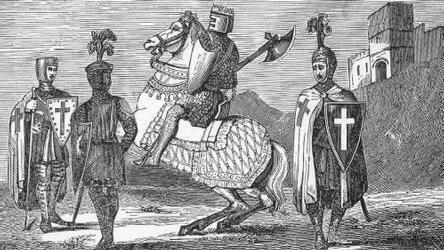The seal of the Knights incorporated the image of a horse with two riders, the Knights originally being too poor to have a horse each. By papal decree the Knights Templar were dissolved in 1312 and much of their property was given to the Hospitallers. In effect the two orders merged.
2015: An exhibition inside the Temple Church about Magna Carta included the following text which we found helpful in that it gives: the origins of the Knights Templars; their relationship to this location; this location's connection to Magna Carta. And, this location being the Inns of Courts, we think that solves a long-standing puzzle of ours - why is the American Bar Association so involved with the Runnymede Magna Carta memorial.
Text from the exhibition (shortened and edited):
The Christian crusaders captured Jerusalem in 1099. In the coming years, pilgrims flooded to the Holy Land. Around 1119 a small group of knights in Jerusalem offered to form a religious order to protect such pilgrims. The King of Jerusalem gave them their headquarters on the Temple Mount…. The knights then became known as the Knights Templar….. {In London} the Church was built by the Knights Templar. The Round Church, in use by 1162, was designed to recreate here in London the shape and sanctity of the round Church of the Holy Sepulchre in Jerusalem……The Templars were monks and soldiers together. They were also bankers and diplomatic brokers to successive kings; the Temple itself was at the centre of England’s religious, political and economic life. The Temple was King John’s London headquarters in the crisis, 1214-15…….From here he issued major preliminary charters, and here in January 1215 he was confronted by barons…… that led to Magna Carta in June 1215.
The Templars were suppressed at the start of the 14th century. In 1608 – when the Church was already over 400 years old – James I granted all the Templars’ former land between Fleet Street and the River to the societies of Inner and Middle Temple, two of London’s Inns of Court. The Inns’ members were central to constitutional development in England throughout the 17th century and in America throughout the 17th and 18th centuries. In both cases, Magna Carta was an icon of liberty. The Inns undertook, in return for the grant by James I, that they would maintain the Church in perpetuity for the celebration of divine service.
2017: The Templars are a complex topic. We found this Guardian book review by Christopher de Bellaigue very informative.









Comments are provided by Facebook, please ensure you are signed in here to see them